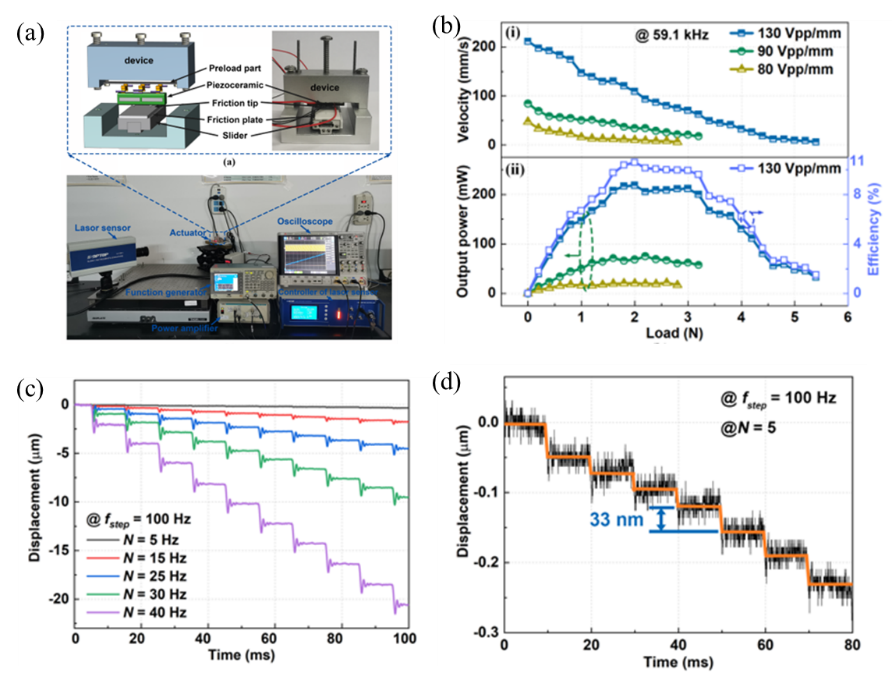Ultra-high precision positioning and actuating technologies have been utilized extensively in many scientific and national strategic industrial fields, such as aerospace engineering, semiconductor lithography apparatus, biological manipulation, and robotics. Compared with the widely-used conventional electromagnetic actuators and electrostatic actuators, the piezoelectric actuators exhibit the unique superiorities in superhigh positioning resolution and positioning self-lock when power is off, rending them particularly attractive for ultra-high precision actuating and positioning applications. However, it is difficult for most piezoelectric actuators to guarantee the high driving performances and high stepping resolution at the same time. In detail, non-resonant actuators are suitable for the scenarios where a high resolution is required, but at the cost of low power capacity and low driving velocity; in contrast, resonant actuators have high output performances but a low stepping resolution.Therefore, to meet the diversified demands of scientific and industrial application fields, it has been a challenge for a piezoelectric actuator operating in single-mode to possess excellent comprehensive characteristics, such as miniaturization, wide motion velocity range, high stepping resolution, and large power capacity.
Nowadays, by imitating bicycle’s movement, Prof. Shuxiang Dong’s group reported a high-power-density bar-type linear piezoelectric ultrasonic actuator (LPUA) operating in the single second-bending (B2) mode with the elaborated structure design. Two driving tips are attached to two ends of the bar-type piezoceramic with the highest vibration amplitudes.Under only asingle-phase sinusoidal voltage, two reversed or asymmetric bending along the diagonal of the ceramic bar can be obtained, and it should be noted that the whole vibration amplitude is enhanced because of the synergistic effect ofd31andd15modes. Determined by the asymmetric vibration shape ofB2mode, there is a phase shift of 180° between two friction tips, meaning that the piezoceramic bar has a larger driving load capacity since the slider is driven by two friction heads twice in a cycle, in contrast to the traditional linear piezoelectric actuator that drives the slider only once in a cycle.

Figure 1. Simulated motion trajectories of two friction tips of theB2-LPUA operating in bicycle movement mechanism.
Attributed to the bicycle driving mechanism and the synergistic effect ofd31andd15modes, the proposedB2-LPUA shows excellent comprehensive actuation performances, such as high driving velocity (211 mm/s), large driving load (5.4 N), large load density (243 mN/cm3), high stepping resolution (33 nm), and wide controllable velocity range (3.3 μm/s ~ 211 mm s), etc.Especially, its output power density is twice larger in comparison to the most of reported LPUAs and there is no modal decoupling problem to be worried about. These unique advantages render it potential for high-precision positioning and actuating technology fields, such as robot joints and minimally invasive medical instruments.This study also confirms that bionic motion design may provide new ideas for the further development of novel piezoelectric actuators.

Figure 2. Output characteristics of the single-modeB2-LPUA. (a) The single-mode LPUA and its experimental setup. (b)The moving velocity, output power, and efficiency versus mechanical load under varying driving voltages. (c) The real-time displacement responses with varying wave numberN. (d) The step motion with the resolution of 33 nm whenN= 5.
The related research was published inIEEE Transactions on Industrial Electronics, entitled “A High-Power-Density Piezoelectric Actuator Operating in Bicycling Movement Mechanism” (DOI: 10.1109/TIE.2022.3190900).The first author of this paper is the Ph.D. candidate, Zhanmiao Li (2018), and Prof.Shuxiang Dongis the corresponding author of the paper. The work has also been applied for a Chinese invention patent.